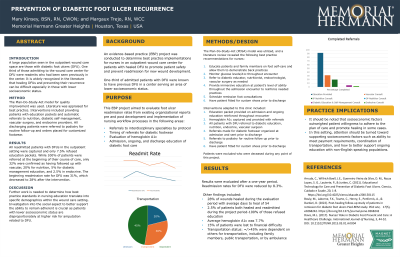Evidence-Based Practice
(EBP-011) Prevention of Diabetic Foot Ulcer Recurrence

A large population seen in the outpatient wound care space are those with diabetic foot ulcers (DFU). One third of those admitting to the wound care center for DFU were readmits who had been seen previously in the center. It is widely recognized in the literature that healing DFUs and preventing their recurrence can be difficult especially in those with lower socioeconomic status. This evidence-based practice project was performed to determine best practice implementations for nurses in the outpatient wound care center.
Methods:
The Plan-Do-Study-Act model for quality improvement was used. Literature was appraised for best practice guidelines in nursing to promote prevention of recurrence of DFUs. Interventions included providing patients with education packets and automatic referrals to nutrition, diabetic self-management, vascular surgery, and endocrine providers. All discharging patients were referred back to podiatry for routine follow-up and orders placed for customized footwear. Readmission rates were evaluated after 6 months pre and post intervention.
Results:
All readmitted patients with DFUs in the outpatient setting were captured. Patients were offered education packets with the exception of 7.5% who refused. While 100% of patients were referred to vascular, nutrition, endocrine, and diabetic management education at the beginning of their course of care, only 32% were confirmed as having followed up with vascular, 20% for nutrition, 5% for diabetic management education, and 2.5% in endocrine. The beginning readmission rate for DFU was 31%, which decreased to 28% after the intervention, with an overall reduction rate of 8.3%.
Discussion:
Further work is needed to determine how best practice standards in nursing education translate into specific demographics within the wound care setting. Education packets were limited for non-English speakers, and transportation and socioeconomic status had a large impact on whether patients remained adherent to their plans of care regardless of education. While education is needed to further DFU prevention, investigation into the social aspect to better support the ability to remain adherent is crucial as patients with lower socioeconomic status are disproportionately at higher risk for amputation related to DFU.

.jpg)